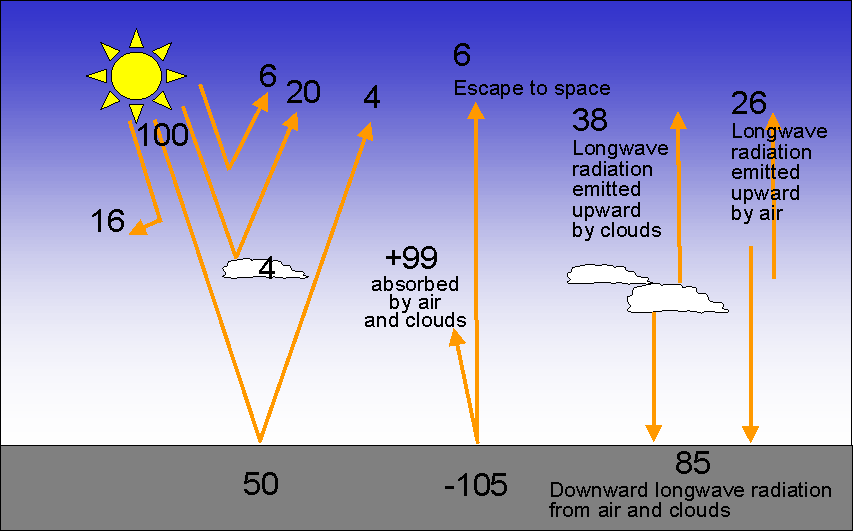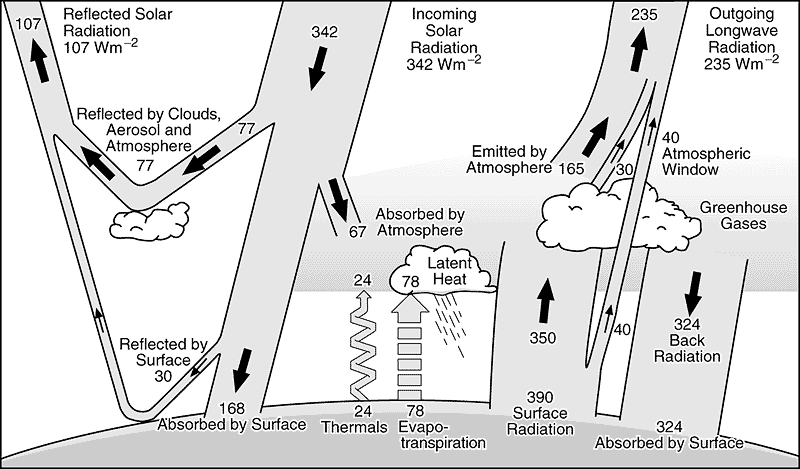On the previous page we looked at the absorption of solar radiation by the Earth. This is the energy into the planet Earth. Because the average temperture of the Earth is nearly constant from year to year, using the principle of energy balance, we know that the radiation energy emitted by the Earth must equal the radiation energy absorbed from the Sun. Using the radiation laws, we could compute the average temperature for the planet Earth, which we called the radiative equilibrium temperature. As mentioned on the previous page, the radiative equilibrium temperature of the Earth is -15°C (0°F). This is actually the average temperature at which radiation is emitted from the Planet Earth. If there were no atmosphere (and no change in the amount of solar radiation energy absorbed by the planet), this would be the average temperature at the Earth's surface.
The radiative equilibrium temperature of the planet Earth (based on the amount of radiation energy that the planet emits to space) is quite a bit colder than the average temperature of the Earth's surface. The reason this is possible is because the atmosphere plays a large roll in the emission of infrared radiation out to space. In effect, it slows down the net rate at which the ground surface cools by radiation. This is known as the greenhouse effect. This WORD document describing the fundamentals of the greenhouse effect offers a simplified explanation for how it operates. You should take the time to open and study the WORD document before reading further.
Let's try to make a simple analogy that may help you understand how the atmospheric greenhouse effect results in a warmer surface. The simple analogy is keeping warm by covering yourself with blankets. Let's assume that the human body generates internal heat at a constant rate. (Of course this is not true because the body uses thermoregulation to maintain a near constant temperature). The internal heat generated will cause the surface temperature of your body to heat up to the point where the energy out equals the internal energy generated. This is like the concept of radiative equilibrium temperature for the Earth. Now suppose a blanket is placed over the body. This will slow down the net rate of heat loss from the surface of the body as some of the heat given off by the body will be absorbed by the blanket and returned to the body. As a result the surface temperature of the body will start to increase since the net rate of heat loss (at the body surface) is now less than the heat input or internal heat generation. The surface of the body will continue to warm until the net rate of heat loss again equals the rate of internal heat generation. However, this will be at a higher temperture than before the blanket was put on. So even though the energy input did not change, the surface temperature of the body became warmer because the blanket slowed down the net rate of heat loss from the body. Somewhere on the outside surface of the blanket the temperature would be such that radiative equilibrium is satisfied (energy lost by the system equals the energy input), but it is warmer underneath the blanket at the body surface. This is very much like having a greenhouse atmosphere. Greenhouse gases slow down the net rate at which the Earth's surface loses radiation energy, while still allowing the energy input (from the sun) to mainly heat the surface. So even with no change in the energy input from the sun, adding greenhouse gases to the atmosphere will make the surface warmer than if there were no greenhouse gases or greenhouse effect. Adding more greenhouse gases, i.e., strengthening the greenhose effect should make the Earth's surface warmer just like adding more blankets would act to make the surface of the body warmer. A big question, of course, is how much warmer will the surface of the Earth become as the concentration of greenhouse gases in the atmosphere increases?
Review basics of the greenhouse effect with a few details added:
The precise details of the greenhouse effect are quite complicated. For example if we were to look more closely at how individual gas molecules interact with different types of radiation, it gets very complicated. The simplified explanation provided above is sufficient to understand the basic operation of the greenhouse effect.
You should understand that the natural greenhouse effect on Earth is not a bad thing. In fact it is necessary for life as we know it to exist. If there were no greenhouse effect, the temperature of the Earth's surface would be 0°F, and most water would be frozen. The concern with anthropogenic global warming is that of an enhanced greenhouse effect whereby the surface temperature of the Earth will increase above the present value of 59°F. One way this could happen is by increasing the concentrations of greenhouse gases in the atmosphere. It is a fact that human activities are adding greenhouse gases to the atmosphere and that their concentrations in the atmosphere are increasing.
Let me try to simplify how additional greenhouse gases may act to warm the surface temperature:
The greenhouse effect also occurs on other planets. Depending upon the composition of the atmosphere, the greenhouse effect can be quite strong. For example, lets look at Venus:
The Planet Venus
First let's add the outgoing Earth radiation on the same diagram as the solar energy input. All of the energy units shown have been normalized, such that 100 units is the amount of radiation energy from the Sun that hits the top of the atmosphere. Upward longwave (infrared) radiation from Earth's surface is largely absorbed by clouds and atmospheric greenhouse gases. Some, however, escapes directly into space. In normalized units, the Earth's surface radiates 105 units of infrared energy upward. Atmospheric gases (water vapor, carbon dioxide, and other greenhouse gases) and clouds absorb 99 of the 105 units of infrared radiation energy emitted by the Earth's surface, while only 6 units of infrared radiation energy emitted from the ground goes directly off into outer space. Greenhouse gases and clouds also emit radiation both upward (64 units) to space, which cools the planet, and downward (85 units) to warm the Earth's surface. This behavior is commonly referred as the Greenhouse Effect. The figure below shows all of the radiational energy exchanges into, out of, and within the Earth-Atmosphere system. For the entire planet, the radiation energy in equals the radiation energy out, which determines the radiative equilibrium temperature. (The numbers on the arrows that point out of the top of the atmosphere add up to 100, which equals the solar energy that comes in at the top of the atmosphere.) However, note that the Earth's surface absorbs more radiation energy than it emits, while the atmosphere emits more radiation energy than it absorbs. The surface absorbs 135 units of radiation energy, but only emits 105 units (+30 for radiation), while the atmosphere absorbs 119 units, but emits 149 units (-30 for radiation).

Without some other types of energy exchange beside radiation between the Earth's surface and the atmosphere, we would expect that the Earth's surface would be warming (energy in > energy out) and the Earth's atmosphere would be cooling (energy out > energy in). This does not happen because there is a transfer of energy from the surface to atmosphere through latent heat (moist convection) and sensible heat (dry convection and conduction) transfers that balances energy in with energy out, so that both the surface and atmosphere remain at a nearly constant average temperature when averaged over yearly time periods (see figure below).

Summarizing the energy balances:
 |
| The Earth's annual and global mean energy balance. Of the incoming solar radiation, 49% (168 Wm-2) is absorbed by the surface. That heat is returned to the atmosphere as sensible heat, as evapotranspiration (latent heat) and as thermal infrared radiation. Most of this radiation is absorbed by the atmosphere, which in turn emits radiation both up and down. The radiation lost to space comes from cloud tops and atmospheric regions much colder than the surface. This causes a greenhouse effect. |
If you consider only the radiation terms, the Earth's surface absorbs more radiation energy than it emits and the atmosphere emits more radiation energy than it absorbs. The radiation imbalances are made up for by convection and conduction. These radiation imbalances drive the overturning circulations of the atmosphere, which for the most part is manifested in the formation of clouds and storms. Another way to look at it is the bottom of the atmosphere (where it touches the surface) is heated by the radiation imbalance that takes place at the Earth's surface (radiation energy in > radiation energy out), while higher up, the atmosphere cools by radiation (radiation energy out > radiation energy in). This generates the instability (warming air below cooling air) that sets that stage for rising vertical motion, cloud formation, and storms. In fact radiation drives the system toward being unstable (by warming the surface and cooling the atmosphere) and when it gets too unstable, overturning happens, often resulting in clouds and precipitation, which transfers energy from the surface upward into the atmosphere.
Radiation imbalances also drive horizontal weather and ocean circulations that transport energy from the tropics where there is a surplus of radiation energy (solar radiation absorbed > radiation emitted to space) to the polar regions where there is a deficit of radiation energy (solar radiation absorbed < radiation emitted to space). This is shown in the figure below. You should be able to understand what is shown in the picture. The red line represents the amount of solar radiation absorbed at different latitudes (this is the radiation energy input), while the blue line represents the radiation energy emitted to space at different latitudes. "Surplus" shows the latitudes where the radiation energy in from the sun is greater than radiation energy emitted to space while "Deficit" means the opposite. Again without some energy exchange between different latitudes, the surplus areas would be getting warmer with time and the deficit areas would be getting colder. However, energy is transported across latitudes by the large-scale atmospheric and ocean circulations. The heat transfer labeled in the figure below is accomplished by atmospheric circulations (about 60% of the transfer) and ocean currents (about 40% of the transfer). Another way to to look at it is that atmospheric and oceanic circulations moderate the temperature differences between the tropics and the polar regions. If these circulations did not occur, the tropics would be much hotter and the polar regions would be much colder.
 |